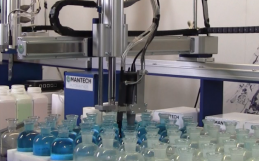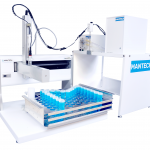Controlling Treatment Disinfection Byproduct Creation from Natural Organic Materials
Justin Dickerman, EIT, MANTECH
Published in Environmental Science & Engineering, June 2018
Safe operation of a water treatment plant requires careful monitoring of the water supply for any substances entering the treatment works that could negatively impact treated water quality. One aspect of water quality that has recently garnered more attention from authorities and utilities is natural organic matter (NOM). This is a group of carbon-based compounds found in natural water systems and formed by the decomposition of organic materials and associated metabolic reactions.
NOM itself does not pose a risk to human health. However, some NOM compounds are known to react with chlorine and chloramines in drinking water treatment to produce disinfection byproducts (DBPs) such as trihalomethanes (THMs) and haloacetic acids (HAAs), which are known to be carcinogenic and/or genotoxic. Health Canada, the US Environmental Protection Agency, and the World Health Organization include sections focused on control of DBPs in their drinking water treatment guidelines.
Preventing disinfection byproduct formation is a multi-faceted issue for drinking water utilities. A variety of strategies are being developed for both general treatment and specific plant/source conditions. Each facility and water source is different; therefore, no one strategy can be applied. Often, utilities are encouraged by their local authority to have a unique monitoring plan developed.
Prevention strategies can be generalized into four groups (reference WHO 2006):
- Optimization of treatment conditions to remove precursor NOM compounds
- Using a different chemical disinfectant with less tendency to form byproducts
- Using a non-chemical disinfectant
- Removing DBPs prior to distribution
Since drinking water plants typically maintain a disinfectant residual in the distribution system, use of solely a non-chemical disinfection is often not an option. Similarly, most guidelines specify chlorine of chloramines for disinfection; therefore, it can be difficult and costly to switch to a different chemical disinfectant.
Removal of DBPs before distribution is often not practical, due to high implementation costs and uncertainty as to whether the DBPs are forming at the plant or in the distribution system through reactions with residual disinfectant. Therefore, the preferred prevention strategy for most utilities is optimization of treatment conditions to remove precursor NOM compounds.
For utilities beginning to address DBP formation through removal of precursor compounds, it is critical to gain an understanding of the NOM present in the source water matrix influent to the plant. This is especially important for sources that experience seasonal/temporal variations, which is common for many surface water systems and some groundwater systems.
Traditional parameters for monitoring of source and treated waters include: total organic carbon (TOC), dissolved organic carbon (DOC), and ultraviolet absorbance at 254 nm (UV254). These parameters are complimentary to each other, providing different insights into the overall NOM makeup. However, they each have shortcomings and individually do not reveal the full picture. Recently, a new photoelectrochemical oxygen demand (PeCOD) method has been developed for fresh water systems. Its low detection limit (<1 ppm), rapid analysis time (<5 min), and streamlined operation allow utilities to implement for source monitoring.
ASTM International has published a new method specific to PeCOD (D8084), and the Canadian Ministry of the Environment and Climate Change has also published a method for the PeCOD in surface waters (E3515).
One drinking water utility, which receives source water from a river, sees a great amount of variation in source water quality throughout the year, and even from events such as storms and rapid snowmelt. In early 2017, they implemented PeCOD alongside TOC and UV254 in an online monitoring system. Their goal was to use real time monitoring of these parameters to develop a model for dictating treatment actions, such as pH adjustment and coagulant dosing.
The first stage of this project was to establish baseline conditions for each of the parameters, as well as comparing their response to events known to influence NOM.
The comparison showed the value of the PeCOD parameter in the application of source water monitoring. The data indicates that PeCOD can successfully capture/detect any event detected by UV254 or TOC, and suggests that PeCOD can capture/detect a greater fraction of the NOM than the other parameters for certain events.
The next stage of this project is to utilize a THM analyzer alongside the online analyzers monitoring source water, which mimics disinfection to form then measure THM DBPs. The utility will develop correlations and trends for each parameter, as well as combinations of parameters, to actual disinfection byproduct formation.
Implementation of the Online PeCOD Analyzer has already given the utility a barrier of protection, in that the operators constantly check the value to get an idea of the incoming NOM to the plant. As more data is collected, the operators will continue to establish connections between measured values/behaviour and real plant decisions; improving their operation efficiency and leading to reductions in operating cost.
Download the PDF here.







